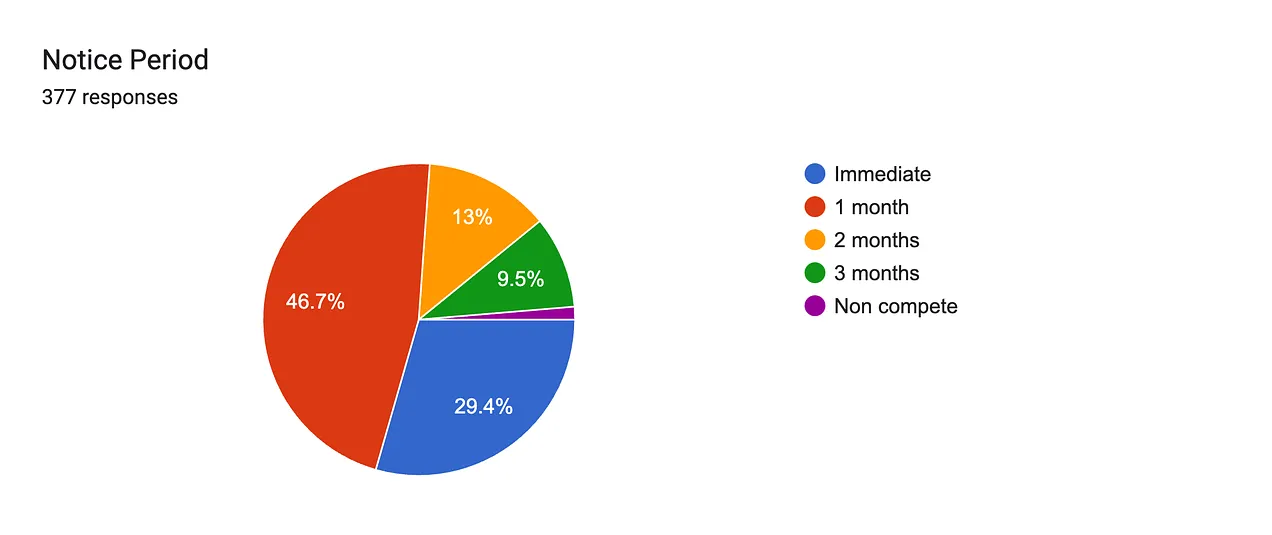Exploring whether extended notice periods reflect operational challenges—and why shorter exits might be the way forward.
 Data collected by Rockrose from interviews with over 377 candidates since early 2024.
Data collected by Rockrose from interviews with over 377 candidates since early 2024.
The chart provides insight into employee notice periods, showing that nearly half of the respondents need to give one month’s notice (46.7%), while almost a third can leave immediately (29.4%). A smaller percentage serve two- or three-month notices. This raises questions about whether lengthy notice periods are necessary across the board, especially for junior roles.
What Long Notice Periods Really Mean
Extended notice periods can reflect inefficiencies within a company, suggesting rigid processes and recruitment challenges. While senior roles might require longer transitions, holding junior employees to the same standard may indicate an outdated approach. Companies often cite the need for replacement time, but if hiring consistently takes longer than expected, the underlying issue might be a slow recruitment process rather than a need for extended notice.
Do We Really Need Long Notice Periods?
With advancements in technology, handovers are more efficient than ever. AI-driven documentation and centralized knowledge systems allow employees to transfer responsibilities quickly. Well-maintained documentation and automation tools help make lengthy handovers unnecessary, even for complex roles.
Shorter notice periods benefit both employees and employers. Employees can transition to new opportunities without delay, and companies avoid prolonged exits, which can strain team morale. Additionally, shorter notice periods can reduce potential data security risks by limiting the duration in which departing employees have access to sensitive information. This approach helps protect proprietary data while allowing the organization to maintain a smoother transition.
Employer Concerns: Finding Replacements and Ensuring Continuity
Employers argue that longer notice periods allow for thorough recruitment and knowledge transfer. However, if hiring processes are inherently slow, extended notice periods only mask the issue. By optimizing recruitment strategies, companies can reduce reliance on lengthy notice periods. In addition, clear, continuous documentation within teams can alleviate the need for prolonged transitions.
Short vs. Long Notice Periods: Key Considerations
Benefits of Shorter Notice Periods:
- Operational Efficiency: Drives companies to adopt quicker hiring and handover processes.
- Focused Handover: Short timelines push for effective, streamlined transitions.
- Enhanced Data Security: Minimizes the period in which departing employees can access sensitive information.
- Boosts Morale: Reduces the time teams spend working around a departing employee, helping maintain focus and engagement.
Reasons for Longer Notice Periods:
- Specialized Hiring Needs: More time may be required for niche roles.
- Business Continuity: Ensures stability during the transition in complex positions.
Why Shorter Notice Periods Are Often the Way Forward
In today’s fast-paced business world, organizations that embrace flexibility are better positioned for success. As the chart indicates, most employees require only a month’s notice or can leave immediately, suggesting that shorter notice periods are both feasible and sufficient for most roles. Embracing shorter notice periods can reflect a company’s operational efficiency, promote a smoother handover, and boost employee morale by providing a clean break. In turn, this positions the organization as a forward-thinking, agile place to work—one that’s responsive to change, respects employee transitions, and prioritizes a streamlined, secure handover process.